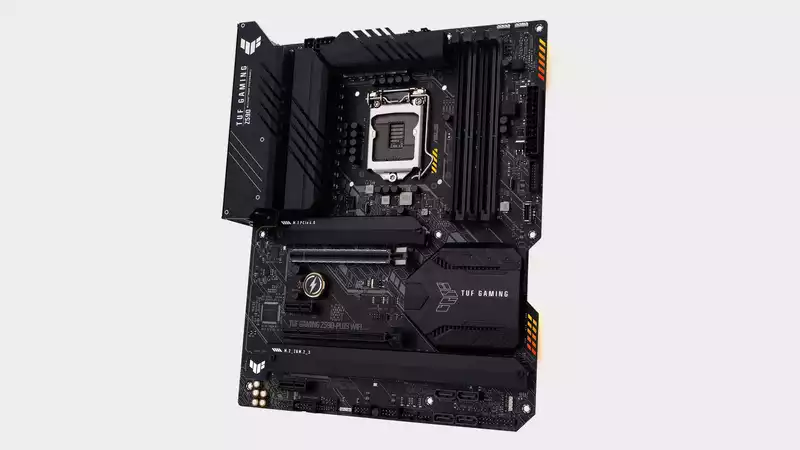The Asus TUF Gaming Z590-Plus Wi-Fi is a gaming motherboard positioned as an entry-level Intel Z590 board for Rocket Lake Asus' TUF products focus on reliability, and this pricing and basic feature set combined should make it a good, affordable option for those seeking a hassle-free, solid, and reliable system. But does this TUF have what it takes, or is TUF good enough [snip]
Z590 boards like the Asus TUF and the MSI MPG Z590 Gaming Carbon W-Fi are clearly an improvement over their Z490 predecessors. Key features include PCIe 4.0 support, allowing Intel users to finally take advantage of the latest and greatest SSDs, doubled CPU-to-chipset DMI bandwidth, and native 20Gbps USB 3.2 support.
Add to that unofficial support for ultra-fast DDR4-5000+ memory, a higher-spec VRM design, and improved networking capabilities, and you have a powerful platform. the Intel Core i9 11900K may not impress us, but the Core i5 11600K and even entry-level ones like the Core i5 11400 can get on the Rocket lake rocket and get a feature-rich platform.
Asus' TUF series (TUF stands for The Ultimate Force) has changed a bit from its original emphasis on military-class reliability. When gaming became the main driver of PC sales, the TUF brand went with the flow.
TUF boards are now positioned as the third tier of Asus' gaming product line, below the flagship ROG series and the upper mid-tier Strix series. The themes of reliability and stability are still present, and the more subtle yellow-accented design is welcomed by many users who shun the price tag of high-end motherboards; the TUF Z590 Gaming is a set-up, turn on XMP, and boot it up, and you can almost forget about the board.
Well, that's what it is anyway.
The TUF Z590 Plus features a particularly beautiful white font with a subtle design. A few small RGB letters are scattered on the right side. Lovely looking, it has three M.2 slots, the top slot being PCIe 4.0 compatible. The bottom two are housed under a single heatsink. Also of note, although it may be disconcerting to cable management aficionados, are the vertical SATA ports. Next to the heatsinks are two more regular horizontal ports. There are also six fan headers and two addressable RGB headers.
Nothing particularly surprising here, and it is nice to see USB Type-C case headers becoming more common.
Due to the power-hungry Rocket Lake architecture, a cheap VRM solution is an absolute no-no for the Z590 board. Thankfully, the TUF Gaming Z590 has a 14+2 phase DrMOS power delivery system, cooled by two heatsinks, which is more than adequate for its size; a 10-minute Cinebench loop showed a recorded temperature of only 60°C. The 6-pin and 8 pin power connectors, sufficient for 11900K with adaptive boost, but note that this is not a board to be used for AVX overclocking without offset.
I/O is back-to-basics: in addition to a Type-C 20Gbps USB port, there are two USB 3.2 Gen2, two 3.1 Gen1, and two 2.0 ports (the USB naming sucks); Wi-Fi 6 (not 6E) and 2.5G Ethernet are sufficient for a typical gaming HDMI and DisplayPort are also welcome. The audio system includes the budget Realtek S1200A codec.
System Performance
Gaming Performance
In terms of performance, the Asus performed as expected in its default state, but with Adaptive Boost enabled it tended to lag behind the other boards tested. However, power consumption and performance are highly correlated with Rocket Lake, so this is not too negative; the CPU's peak power consumption was about 30W less under Adaptive Boost load compared to the MSI Gaming Carbon.
Asus seems to have adjusted the power management on this board to be a bit more conservative; given that Rocket Lake is a power hog, there is nothing wrong with this; with 4-pin and 8-pin power connectors, Asus does not seem to want users to consume more than 300W for extended loads. It appears that Asus does not want users to consume more than 300W for an extended period of time.
Looking ahead to the RMA numbers for the Z590 board in six months, this may prove to be a wise decision, especially given Asus' emphasis on reliability for the TUF series boards.
Overclocking says nothing about the motherboard and only reinforces how limited cooling is for the Core i9 11900K, even with a high-quality 360mm AIO cooler, although it needs 1.42V to pass a heavy benchmark at 5.1GHz, Asus did not object.
The Asus TUF Gaming Z590 Plus Wi-Fi won't win the specs battle, but you can't expect to pay $260 for it. It would be an affordable option for those who laugh at the idea of paying $500+ for a motherboard.
There are a few core considerations to take into account with this board. First, it supports the Core i9 11900K with Adaptive Boost enabled to keep the VRM running cool. Additionally, it has important core features such as Wi-Fi 6, 2.5G LAN, and support for the fastest PCIe 4.0 SSDs.
This board is for users who want to redirect their money to faster GPUs and higher capacity SSDs instead of paying through the nose for 10G LAN and expensive add-in cards. And I can totally agree with that. It delivers bang for the buck, and only has what you need. Definitely a product to look out for if you're on a budget.
.

Comments